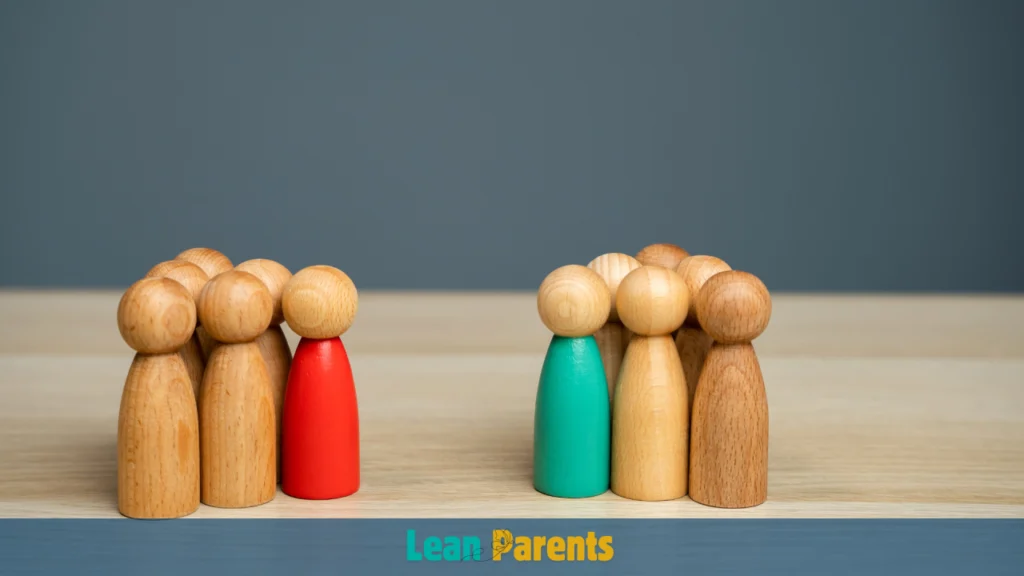Turning Conflict into Harmony with Siblings: As a parent, I’ve seen the ups and downs of sibling relationships. Laughter can quickly turn into fights, leaving me feeling lost. Many parents face this, with1 siblings often fighting over things like attention and feeling safe.
Key Takeaways
- Understand the root causes of sibling rivalry and address the emotional needs behind conflicts
- Implement effective communication strategies to promote open dialogue and conflict resolution
- Teach children valuable skills in emotional intelligence and problem-solving
- Engage parents as active participants in shaping a supportive family environment
- Celebrate individual differences and foster a spirit of teamwork among siblings
In this article, we’ll look at ways to make sibling fights into moments of love. We’ll guide you on how to build strong family bonds3. By talking about feelings, encouraging kids to think about their emotions, and teaching them to express feelings well, we can help them get along better.
Understanding the Root Causes of Sibling Rivalry
Sibling relationships can be complex, with conflicts and rivalries often bubbling to the surface. To address these challenges, it’s crucial to delve into the underlying factors driving sibling rivalry. One key driver is the natural human need for attention and validation, as children may compete for parental affection and recognition4.
Sibling rivalry can manifest in various ways, such as acts of cruelty, expressions of jealousy, and attempts to outshine one another4. This struggle for uniqueness and the desire to establish their own identities within the family setting can lead to emotional turmoil and contribute to ongoing rivalry4.
Emotional Needs Behind Conflicts
Conflicts between siblings often stem from deeper emotional needs, such as the need for security, autonomy, and a sense of belonging. Children may try to assert their individuality and showcase their achievements to gain attention and validate their worth, both in comparison to their siblings and within the family dynamic4.
Common Triggers of Sibling Disputes
Sharing resources, including time, space, and material possessions, can be a significant source of tension and conflict between siblings. Disputes over toys, personal space, and parental attention can ignite sibling rivalry4. Acknowledging the range of intense emotions, including anger, jealousy, and resentment, is crucial in managing these conflicts4.
Age-Related Conflict Patterns
Sibling rivalry can persist well into adulthood, as children may continue to compare themselves to their siblings and measure their own worth accordingly4. Infants and toddlers engage in sibling rivalry starting from the ages of three to nine, with conflicts between siblings being common occurrences in households5.
Understanding the root causes of sibling rivalry is the first step in fostering more harmonious relationships. By addressing the emotional needs, common triggers, and age-related patterns, parents can develop effective strategies to turn conflict into cooperation and build stronger sibling bonds.
| Emotional Needs | Common Triggers | Age-Related Patterns |
|---|---|---|
|
|
|
“Sibling rivalry can persist well into adulthood as children may continue to measure their worth against their siblings.”4
By addressing the underlying emotional needs, common triggers, and age-related patterns, parents can develop effective strategies to turn sibling conflict into cooperation and build stronger familial bonds5.
Creating a Supportive Family Environment
Building a harmonious sibling relationship starts with a nurturing family environment. Siblings often fight as they learn to share and cooperate This is part of their social and emotional growth9. It’s important to understand their developmental stages.
Toddlers struggle with sharing, while older kids might fight for attention or school success9.
Setting Clear Family Boundaries
Clear family boundaries and expectations are key for sibling harmony. Personality differences can lead to clashes, showing the need to respect each other’s views9. Setting clear rules helps create a sense of security and fairness.
Establishing Consistent Rules
Clear family rules and routines are crucial for preventing sibling rivalry. They promote fairness and respect9. Consistent parenting and a structured home reduce conflicts and encourage cooperation.
Fostering Open Communication
Encouraging open dialogue is vital for strong sibling bonds. Emotional intelligence grows through talking about feelings and learning mindfulness9. This helps manage emotions and solve conflicts in a healthy way.
Creating a supportive family environment is key to effective parenting. By setting clear boundaries, following consistent rules, and encouraging open communication, families can overcome sibling challenges. This builds a strong, resilient bond among children.
Effective Communication Strategies for Siblings
Sibling relationships are filled with joy, laughter, and sometimes conflict. Sibling squabbles are normal and understanding them is crucial for strong bonds10. Parents can help by teaching their kids to communicate well, solve problems peacefully, and understand each other better.
Active listening is key in sibling communication. Teach your kids to reflect what their sibling says to ensure they understand each other. This makes the other feel heard and opens up a chance for good talks11. Also, teach them to say “I feel frustrated when…” instead of “you always…” to avoid fights.
| Communication Strategies | Benefits |
|---|---|
| Active Listening | Promotes mutual understanding and empathy |
| “I” Statements | Avoid blame and encourage self-expression |
| Empathy-Building Exercises | Foster emotional intelligence and compassion |
| Collaborative Problem-Solving | Empower siblings to work together towards solutions |
Doing empathy-building exercises can also help siblings appreciate each other more11. By teaching them to solve problems together, you improve their teamwork and communication skills.
Improving sibling communication is a journey worth it. Managing sibling rivalry can be tough, but teaching your kids to communicate and solve problems can make their relationship better10.
Teaching Conflict Resolution Skills

Sibling rivalry is a normal part of family life. But, with the right tools, parents can help their kids handle conflicts well12. By teaching kids how to solve problems, parents boost their emotional smarts, social skills, and toughness13.
Problem-Solving Techniques
Teaching kids how to solve problems is crucial for peaceful conflicts. It’s about letting them share their feelings, listen to others, and find solutions they both like14. Giving kids choices in solving conflicts makes them feel more involved14.
Peaceful Negotiation Methods
Siblings can learn to negotiate by listening actively and compromising14. Teaching them to manage their feelings during fights helps them negotiate better13. Techniques like taking a break, counting to ten, or deep breathing help them calm down and think clearly13.
Anger Management Tools
Teaching kids to manage anger is key in sibling fights12. They learn to share their feelings without blaming, which helps calm things down14. Teaching empathy, rewarding good behavior during fights, and seeing conflict resolution as a skill helps too13.
By using these strategies, families can turn sibling rivalry into peaceful interactions. This strengthens family ties and improves the well-being of their kids. Find more ways to manage sibling and learn how radical empathy can change daily parenting.
The Role of Parents in Sibling Dynamics
As parents, we play a big role in how our kids get along. Conscious, connected parenting can turn sibling fights into peaceful relationships. It’s all about how we handle disputes, show good behavior, and help siblings bond15.
Stopping fights before they get worse is key. Staying calm and fair helps kids share their feelings and find ways to agree16. Setting rules early can also stop mean behavior, teaching kids how to solve problems16.
Being a good example is also vital. Kids learn from us, especially how we treat others. Showing kindness, patience, and clear communication can teach our kids to do the same with their siblings16.
| Parental Strategies | Benefits |
|---|---|
| Providing one-on-one time with each child | Restores harmony in sibling relationships15 |
| Encouraging sibling bonding activities | Reduces conflicts between siblings15 |
| Allowing children to resolve conflicts independently | Fosters negotiation skills and promotes fairness16 |
By being mediators, role models, and relationship builders, we help our kids deal with sibling issues. This way, they learn to solve problems peacefully and build strong bonds with their siblings15. This sets the stage for lifelong harmony16.
Turning Conflict into Harmony with Siblings
Dealing with sibling ups and downs is tough but rewarding. It’s all about turning fights into chances to grow closer. By knowing why siblings fight and using smart strategies, parents can help them get along better.
Practical Steps for Transformation
Siblings shape each other’s social and emotional growth17. Talking openly lets them share feelings safely17. Learning how to solve problems helps them deal with disagreements17. Setting rules and being clear helps avoid big fights17. Teaching empathy makes siblings care more for each other17.
Building Positive Interactions
Things like birth order and gender can cause fights18. Working together makes siblings feel united17. Seeing parents handle conflicts teaches kids valuable lessons17. Giving each child special time and avoiding comparisons can reduce jealousy19.
Creating Lasting Change
Changing sibling fights into peace needs a big plan. Meeting emotional needs, teaching skills, and creating a supportive home helps. This way, parents can help their kids overcome sibling issues and build strong bonds171819.
| Factors Influencing Sibling Conflicts | Impact |
|---|---|
| Birth Order | First-born and youngest children may have advantages over middle children18. |
| Gender Differences | Differential treatment of boys and girls can lead to abusive behavior18. |
| Temperament | Clashes between aggressive and sensitive siblings18. |
| Talent and Achievement | Jealousy and resentment towards siblings who excel18. |
| Developmental Stages | Younger children may lash out, while older ones manipulate situations18. |
| Psychiatric/Developmental Disorders | Shorter tempers leading to more conflicts18. |
| Verbal Fluency | Struggle to defend themselves verbally, leading to retreat18. |
| Parenting Styles | Children mirroring parents’ behavior towards them and siblings18. |
| Environmental Stressors | Financial losses, unemployment, or chronic illness can cause family tension18. |
Understanding these factors and using strategies to tackle them helps families. This way, they can create a harmonious and supportive environment for siblings.
Celebrating Individual Differences
In the world of sibling relationships, it’s key to see and celebrate what makes each child special20. By praising their unique strengths and talents, we help them feel valued and respected20. This way, siblings learn to appreciate and understand each other’s differences20.
Every child is a one-of-a-kind individual with their own personality and dreams21. Instead of seeing differences as problems, we can see them as chances for growth and learning21. By valuing individuality, we help our kids celebrate their uniqueness and find happiness in their differences21.
- Encourage open communication and active listening among siblings, allowing them to share their thoughts and feelings freely21.
- Give siblings chances to work together on projects, helping them appreciate each other’s strengths21.
- Always recognize and praise each child’s achievements, boosting their confidence and self-worth20.
- Stay away from comparing siblings, as it can cause resentment and low self-esteem21.
- Make sure to celebrate each child’s unique interests and talents, showing them they’re valued for who they are20.
By embracing the diversity in our families, we create a place where siblings can respect and support each other’s differences21. This not only strengthens their bond but also prepares them for a world that values diversity21.
As we guide our kids through the ups and downs of sibling life, let’s remember the power of celebrating their differences20. By building a culture of understanding and respect, we can turn conflicts into harmony. We empower our children to embrace the special gifts they each bring to the world21.
Building Team Spirit Among Siblings

Creating a strong team spirit among siblings can turn conflicts into harmony. Parents can help by setting up opportunities for siblings to work together. This can be through family projects or shared goals, which are key to reducing rivalry and strengthening bonds2223.
Collaborative Activities
Get siblings to work together on activities like solving puzzles or building LEGO structures. These tasks help them communicate, solve problems, and feel a sense of accomplishment22.
Family Projects
Get siblings involved in big family projects, like redecorating a room or planning a vacation. When they work together, they learn to value each other’s strengths. This builds a stronger sense of teamwork and family collaboration23.
Shared Goals
Encourage siblings to set goals together, like saving for a family trip or a home project. Working together to reach these goals teaches them the value of sibling bonding and teamwork22.
By promoting teamwork among siblings, parents help them develop important life skills. They also strengthen their bonds and create lasting memories23.
| Collaborative Activities | Family Projects | Shared Goals |
|---|---|---|
| Puzzles | Redecorating a room | Saving for a family outing |
| LEGO structures | Planning a family vacation | Completing a home improvement project |
| Scavenger hunts | Organizing a community service event | Raising funds for a charitable cause |
“Teamwork is the ability to work together toward a common vision. The ability to direct individual accomplishments toward organizational objectives. It is the fuel that allows common people to attain uncommon results.” – Andrew Carnegie
By promoting teamwork, family collaboration, and sibling bonding, parents create a supportive environment. Here, siblings can thrive and grow together2223.
The Impact of Comparison and How to Avoid It
Sibling relationships can bring joy and conflict. It’s natural for kids to compare themselves to their siblings. But, this can deeply affect their self-esteem, goals, and family life24.
Studies show sibling comparisons can lead to jealousy, resentment, and hostility25. This can make it hard for siblings to have a strong, supportive bond. Instead, it can create a competitive and discordant atmosphere. Parents need to understand these negative effects and work to make family life more harmonious.
- Encourage Individuality: Celebrate each child’s unique strengths, talents, and interests. Avoid comparisons that make one child seem “better” than another25.
- Set Individual Goals: Help each child set their own goals and milestones. Focus on their progress, not how they compare to their siblings25.
- Foster Self-Esteem: Give each child unconditional love and support. Emphasize their inherent worth. Don’t use comparisons as a way to motivate or discipline25.
By focusing on individual growth, parents can create a supportive environment. This environment celebrates each child’s unique contributions and fosters respect24. This approach strengthens sibling bonds and helps children feel confident in pursuing their goals25.
The key to avoiding sibling comparison is to value each child and promote individual growth25. By doing this, parents can raise well-adjusted, self-assured kids. These kids will be eager to support and celebrate each other’s achievements24.
Quality Time Strategies for Each Child
Building strong bonds with each child is key for family harmony. Spending quality time alone with your kids helps avoid sibling fights. Research shows that 70% of kids love being treated uniquely26.
One-on-One Activities
Make time for activities just for each child. You could take them on a special trip, play their favorite game, or talk without interruptions27. These moments make them feel special and less likely to fight for your attention27.
Creating Special Moments
Mark each child’s special moments and interests. Plan outings or surprises just for them. This makes them feel valued and boosts their self-esteem26.
Building Individual Bonds
Learn what makes each child unique. Tailor your parenting to meet their needs28. This approach reduces sibling rivalry and strengthens family ties26.
Quality time with each child is good for their growth and family unity. It shows your love and attention, making your family stronger27.
| Benefit | Percentage |
|---|---|
| Positive response to unique treatment | 70%26 |
| Decrease in sibling rivalry with avoiding comparisons | 90%26 |
| Enhanced family harmony with filling love buckets daily | 80%26 |
“Spending quality time individually with each child helped reduce conflicts among their siblings.”
– Parenting magazine survey27
Emotional Intelligence Development in Children
Teaching children about emotional intelligence is key for better sibling relationships29. Siblings fight about eight times an hour29. But, having a supportive sibling bond can lead to better social skills and school success29.
On the other hand, negative sibling ties can lead to depression, substance abuse, and poor grades29. Good sibling bonds are also linked to better mental health later in life29.
Teaching kids to be aware of their feelings, understand others, and get along better can turn fights into peace30. Emotional Intelligence (EI) in families means teaching self-awareness, empathy, and clear communication30. Families that focus on EI handle conflicts better, keep strong bonds, and support each other more30.
Parents are very important in teaching emotional intelligence to their kids29. Using punishment or always being the boss can make sibling fights worse29. But, teaching kids to solve problems together and showing them how to handle conflicts can make things better29.
Also, when parents show how to solve problems in a healthy way, it helps siblings get along better29.
Teaching kids about emotions, empathy, and how to manage feelings is important for a happy home30. Emotional intelligence in families leads to a peaceful and supportive home environment, which is crucial for kids’ emotional health and growth30.
| Skill | Description | Benefits |
|---|---|---|
| Emotional Awareness | Understanding one’s own and others’ emotions | Improved emotional regulation, empathy, and communication |
| Empathy | Ability to recognize and share the feelings of others | Enhanced social skills, conflict resolution, and relationship building |
| Social Skills | Proficiency in interpersonal interaction and cooperation | Better collaboration, conflict management, and social adjustment |
30 Emotional intelligence is key for a strong emotional base and healthy family ties30. Teaching emotional intelligence in schools can lead to better grades and fewer behavioral issues30. Kids might need help with managing feelings and compromising until they’re about 2529.
“Empathy is the ability to step into the shoes of another person, aiming to understand their feelings and perspectives, and to use that understanding to guide our actions.”
Managing Expectations as Parents
Dealing with sibling relationships can be tricky. Parents need to have realistic hopes and be flexible. It’s normal for kids to fight sometimes, but knowing why helps make family life better31. By setting achievable goals, noticing improvements, and changing plans when needed, parents can help their kids get along better.
Realistic Goal Setting
It’s okay if siblings fight sometimes. They might argue about 3.5 times an hour, and many parents say it’s a big issue31. Knowing this helps parents not get too upset when fights happen.
Progress Recognition
It’s important to see and celebrate small improvements in sibling relationships. Even when they fight, siblings still share nice moments about four times an hour31. Praising these moments can help their bond grow stronger.
Adjustment Strategies
Parenting methods should change as kids grow. Younger kids fight more, about 6 times an hour, while older kids fight less, about 3 times an hour31. By changing their approach to meet each child’s needs, parents can support their kids’ growth better.
Creating harmony between siblings takes patience, flexibility, and focusing on the good. By setting realistic goals, noticing the positive, and adjusting their ways, parents can help their kids deal with sibling issues. This way, they can build a supportive and cooperative family.
| Statistic | Value |
|---|---|
| Average Sibling Conflicts per Hour | 3.531 |
| Parents Reporting Sibling Rivalry as Top Conflict | 50%31 |
| Average Sibling Pleasantries per Hour | 431 |
| Younger Sibling Conflicts per Hour | 631 |
| Older Sibling Conflicts per Hour | 331 |
“Fostering sibling harmony requires patience, adaptability, and a focus on progress rather than perfection.”
Creating Positive Reinforcement Systems
Using positive reinforcement can really change how siblings get along. It helps create a place where they support and care for each other. Studies show that up to 90% of fights between siblings can be solved with positive rewards34.
Letting kids feel all their emotions, like anger, helps them deal with problems as adults34. Seeing and joining in on sibling fights can also make kids stronger and better at solving problems34.
- Make a clear reward system for when siblings get along and work together.
- Thank and praise your kids when they show kindness and solve problems.
- Start a daily routine with rituals and pictures to cut down fights by up to 70%34.
Creating a positive place helps kids form strong bonds with their siblings. It teaches them important life skills and makes your family happier. The main idea is to encourage good behavior, not just punish bad ones.
| Positive Reinforcement Strategies | Benefits |
|---|---|
| Verbal Praise | Boosts self-esteem and encourages desired behaviors |
| Reward System (e.g., sticker charts, points, privileges) | Provides tangible motivation and recognition |
| Special Experiences (e.g., one-on-one activities, family outings) | Strengthens individual bonds and creates positive memories |
By using these positive methods, you can change how siblings act and make your family a happier place. Here, cooperation and kindness will grow.
“Positive reinforcement is the most effective way to encourage desired behaviors and build strong sibling relationships.”
Modeling Healthy Relationship Behaviors
As parents, we shape our kids’ views on healthy relationships. Our actions and how we solve problems show them how to handle relationships. Studies show kids often copy what they see in their parents35.
It’s key to show empathy, respect, and to find common ground. This is true in our relationships with our partners and kids35. By staying calm and teaching kids to negotiate, we give them important skills35. We also teach them to value diversity by celebrating their differences36.
Seeing us tackle problems together shows kids that conflicts can be a chance to grow. This helps them build strong, healthy relationships with others35.
FAQ
What are the common causes of sibling rivalry, and how can understanding them help parents address conflicts?
What strategies can parents use to create a nurturing family environment that encourages sibling harmony?
How can parents teach effective communication techniques to help siblings express themselves and resolve conflicts constructively?
What conflict resolution skills are important for parents to teach their children?
What is the crucial role that parents play in shaping sibling relationships, and how can they effectively mediate conflicts?
What practical steps can parents take to transform sibling conflicts into opportunities for growth and connection?
How can parents avoid the negative effects of comparing siblings and promote individual growth?
What is the importance of emotional intelligence in fostering harmonious sibling relationships, and how can parents develop these skills in their children?
How can parents use positive reinforcement techniques to encourage cooperation and kindness between siblings?
What is the significance of parents modeling healthy relationship behaviors, and how can this influence their children’s interactions with siblings?
Source Links
- Turn Sibling Rivalry Into Harmony: A Quick Guide
- Turning Sibling Rivalry into Sibling Harmony
- Why Does One Sibling Target Another: Understanding Sibling Rivalry and How to Promote Harmony at Home
- What Causes Sibling Rivalry? Understanding Root Causes
- Why Does One Sibling Target Another: Understanding Sibling Rivalry and How to Promote Harmony at Home
- The Battle of Brothers: The Old Testament and Sibling Rivalry
- How to Help Your Kids Build Strong Sibling Relationships
- Do Not Quarrel among Brothers
- Keeping the Peace Between Siblings
- Strategies to Manage Sibling Rivalry Effectively
- 10 Tips for Dealing With Sibling Rivalry
- Coping with Sibling Rivalry
- Teach Your Kids How To Resolve Conflicts Without Needing To Run To Mom Or Dad – Kong Academy | Empowering Kids Through Play
- Sibling Rivalry: How to Get Your Kids to Argue Less | Open Arms Wellness
- Why Does One Sibling Target Another: Understanding Sibling Rivalry and How to Promote Harmony at Home
- Parents Top Strategies for Managing Sibling Rivalry | Kids Bedtime Stories | LionHeart Storyz
- Promoting Sibling Harmony: Strategies for Resolving Conflicts
- Managing Sibling Conflicts: The Obvious and Hidden Battles
- 5 Tips for Sibling Harmony
- Effective Strategies to Decrease Sibling Fighting
- Handling Sibling Rivalry: Guide to a Harmonious Home – Osita IBEKWE
- Turning Sibling Rivalry into Sibling Harmony | Suwanee Magazine
- Building Harmony at Home: A Parenting Guide to Managing Sibling Rivalry and Strengthening Family…
- Theoretical Perspectives on Sibling Relationships
- Improving sibling relationships
- Creating Strong Sibling Bonds – Latched Mama
- 8 Ways To Develop Sibling Harmony – Saddleback Parents
- Nurturing Positive Sibling Relationships
- Siblings: Like Kittens Wrestling and Why Fostering a Nurturing Relationship Matters — amy j hammer
- Emotional Intelligence For Families – Motherly
- How To Manage Sibling Conflict & Rivalry: Quick Tips For Parents — New Roots Counseling
- No More Sibling Rivalry! Successful Parenting Secrets to Raising Siblings Who Get Along
- Managing Sibling Rivalry – The Good Play Guide
- Kids Fighting All the Damn Time? Here’s How to Stop the Hitting and Keep the Peace
- Overcoming Sibling Rivalry: A Guide to Rebuilding Relationships
- It is Okay to be Me! Navigating Sibling Conflict





